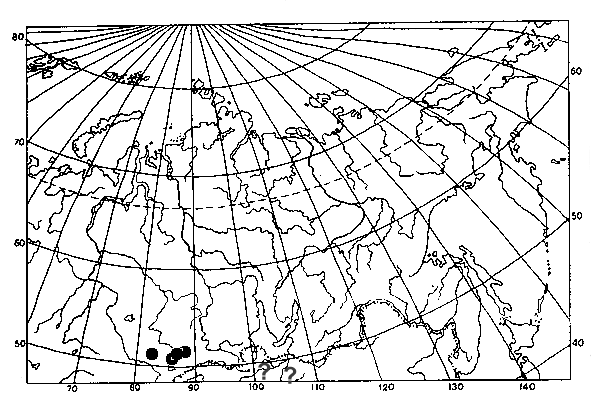

Distribution: NW Africa, C and S Europe, Asia minor, Mongolia. Russia: European part, southern part of West Siberia, including the Altai Mts.
Known localities in Siberia: Russia: Altaiskii Krai: Kolyvan; Altai Republic: 20 km S from Paspaul, Lake Teletskoe (Kyga River), Katu-Yaryk and Chodro on the Chulyshman River, Bulukhta River.
Localities in Mongolia: Polistes omissus Weyr., ssp. kaszabi Giordani Soika, 1970: Selenge (not Central!) aimak: Zuun-Chara. Polistes (Polistes) foederatus albellus Giordani Soika, 1976: Bulgan aimak: 23 km NW from Chutag.
Notes: Determination of this taxon is only tentative, because it belongs to a complex of species which should be thoroughly revised (A.Ćetković, pers. comm.). According to A.Ćetković (who is currently revising the complex in the West Palaearctic area), the name gallicus as applied in the recent literature (i.e. after synonymizations by DAY, 1979 and GUSENLEITNER, 1985) actually refers to a group of closely related species. The complex is distributed from NW Africa and South to Central Europe through Mongolia (GIORDANI SOIKA, 1970, 1976; GUSENLEITNER, 1991), but P. gallicus s. str. has probably more restricted distribution. In Siberia, this is the first record of P. gallicus s. lat., since the specimens listed herewith were formerly misidentified as Polistes biglumis L. (see: DUBATOLOV, 1998), which also occurs in the Altai. Males of this complex differs from the other members of the subgenus Polistes (including P. biglumis L.) by having temporal region short and obliquely converging backwards (as seen from the above), narrow oculomalar space and rounded apical margin of the clypeus. However, some females of this complex could be difficult to separate from the females of P. biglumis L., especially when small specimens are compared (A. Ćetković, pers. comm.). Specimens from the Altai differs from those from Croatia (that were kindly sent by Ozren Polašek) by the structure of the terminal antennal article: in dorsal view it is noticeably elongate with parallel sides in the Croatian specimen, and not so elongate and slightly constricted and widely rounded at the apex in all specimens from the Altai. Siberian specimens differs from the European ones and may belong to a separate species.
References
Day, M.C. 1979. The species of Hymenoptera described by Linnaeus in
the genera Sphex, Chrysis, Vespa, Apis and Mutilla. - Biol.
J.Linn. Soc. 12: 45-84.
Dubatolov, V.V. 1998. Social wasps (Hymenoptera, Vespidae: Polistinae,
Vespinae) of Siberia in the collection of Siberian Zoological Museum. -
Far Eastern Entomologist 57: 1-11.
Giordani Soika, A. 1970. Ergebnisse der zoologischen Forschungen von
Dr. Z.Kaszab in der Mongolei. 223. Vespidae und Eumenidae (Hymenoptera).
- Annales Historico-natureles Musei Nationalis Hungarici. Pars Zoologica
62: 325-333.
Giordani Soika, A. 1976. Vespidi ed Eumenidi (Hymenoptera) raccolti
in Mongolia dal Dr. Z. Kaszab. - Acta zoologica Academiae scientiarum hungaricae
22 (3-4): 271-276.
Gusenleitner, J. 1985. Bemerkenswertes über Faltenwespen VIII (Hymenoptera,
Vespidae). - Nachr. Bayer. Ent. 34 (4): 105-110.
Gusenleitner, J. 1991. Über Vespoidea (Hymenoptera) aus der Mongolei
und der Sovietunion. - Linzer biol. Beitr. 23/2: 631-641.